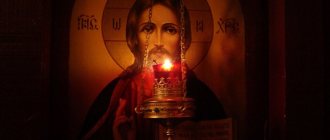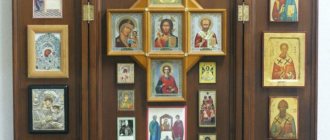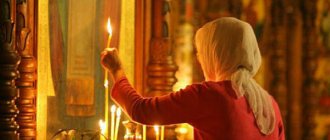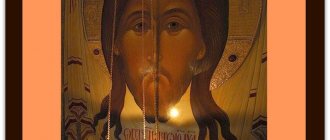Lamps and candles are an image of eternal Light, and also mean the light with which the righteous shine. These are the words of Saint Sophronius, Patriarch of Jerusalem. The Old Testament also mentions the fire of a lamp: “And the Lord said to Moses... that the lamp should burn continually; Outside the veil of the Ark of the Testimony in the Tent of Meeting, Aaron (and his sons) must set it up before the Lord from evening to morning always...”
In this article we will look at the main types of lamps, their differences, features of choosing lamp oil and how to properly light a lamp at home.
Share this article with your friends:
The meaning of Orthodox lamps
Each lamp in Orthodoxy has its own meaning. It is enshrined in the Church Charter of Divine Services. Lamps, in particular, symbolize one of the saints who shine for Christians in the church darkness. In front of the icons, as a rule, a candle and a lamp are placed simultaneously. And if candles mean an offering, a gift to the Lord from humanity, then oil lamps symbolize the transformation of man under the influence of God's grace. Their light and warmth signify a person’s sincerity before God and are evidence of the purity of his thoughts and feelings.
Lamps are used even during the day, when the room or hall of the church is quite light. During the holidays, all lamps must be lit. During night services, with extremely poor lighting, lamps can be lit in very small quantities, for example, only in front of the priest reading the service, in front of individual icons: the Savior, the Mother of God, the temple icon. This is done in order to emphasize the defining moment of the service, its main purpose.
Why are lamps placed in front of the icon?
St. Nicholas of Serbia explained very precisely why lamps are installed in front of the icon. First of all, according to him, faith is light, and lamps remind us of the pure light with the help of which our Lord Jesus Christ warms and heals human souls. In addition, they are symbols of the bright character of the saints in front of whose faces they are installed. They also remind people of their sinful thoughts and actions, call us to the true path, call us to fulfill the commandments and do good deeds.
Lamps are that “small sacrifice” that a person can make to the Savior because He gave his life for him. During prayer, these lamps drive away the forces of evil. The light of the lamp encourages us to humility and sacrifice, reminds us that just as its fire cannot flare up without human participation, so without God our heart cannot flare up.
Design options for lamps
Most lamps consist of a lamp base and a glass inserted into it, into which oil is poured. This glass, as a rule, is glass, less often – ceramic. Lampstander
made of metal, sometimes of ceramics.
Lamps can be divided into hanging
and
standing
. The first ones are equipped with chains connected at the top. With their help, the lamp is attached to a bracket installed above the icon.
Home
(cell) lamps
, as a rule, differ from temple lamps only in size and sometimes the solemnity of decoration. The church lamp is usually larger than the one that illuminates the home holy corner.
Greek lamps are becoming more and more widespread these days.
. They are essentially miniature oil lamps with a glass cover. Their design is the same as that of kerosene lamps, which are more familiar to residents of our country.
What should lamp oil be like?
The quality of lamp oil is of paramount importance. And not only because it affects health in some way. By kindling it, we open our heart to God, which must be pure: there should be no anger, no resentment, no bad thoughts in it. Likewise, oil cannot be of poor quality, cheap, or unclean. The clergy believe that the use of low-quality oil is a sign of impoverishment of faith, a permissive attitude towards piety, and the perception of shrines exclusively as some kind of primitive attribute.
Initially, lamp oil was olive oil. Vaseline is now on sale, as well as its mixture with olive oil. These are the oils:
- have the purest aroma;
- do not contain impurities;
- create minimal carbon deposits;
- do not spoil the icons;
- have a beneficial effect on the skin when anointed.
How do you know if the oil is of poor quality? - Firstly, it will have a pungent odor, since manufacturers try to mask its own unpleasant aroma with various aromatic fragrances. In addition, it can cause allergies, suffocation and headaches. Such oil causes damage to icons and temple utensils.
Since ancient times, lamps have been associated with miraculous events. For example, in the second century, one church ran out of oil right on Easter. The bishop poured water, and it burned through the entire festive service, as if the lamps contained the best oil.
What types of lamps are there?
An Orthodox Christian may have several of these lamps in his home; the choice of a specific option depends on your tastes and the availability of space to place them. Suitable for arranging the Red Corner:
Read also Making a swan from a car tire
They can be simple or decorated with chasing, carving or painting. The glass of the lamp can be of different colors:
- made of red glass - such products look solemn and are used for holidays;
- blue and green are calmer options; they are used during fasting and on weekdays.
It is strictly not recommended to light a lamp from a match (this can only be done from a candle or from a special lit stick), or to use it for household needs, as a regular candlestick or cup.
Since lamps symbolize purity and humility, their fire did not stop burning too brightly. The light should be the size of a match head or a little larger. To achieve such a glow, you need to buy high-quality wicks - natural, waxed, sold only in church shops. It is not scary to entrust this fire to children, who, according to Orthodox traditions, are recommended to be involved in rituals from an early age.
When lighting lamps, an Orthodox Christian must read a special prayer: “Light up, Lord, the extinguished lamp of my soul with the light of virtue and enlighten me, Your creation, Creator and Benefactor, for You are the Immaterial Light of the world, accept this material offering: light and fire, and reward We are inner light to the mind and fire to the heart. Amen".
One of the Orthodox traditions is to anoint a sick person or someone who is in trouble with burnt oil. This is what the monk did. Seraphim of Sarov, who lit lamps for everyone who asked him to pray for themselves or for their deceased relatives.
Once upon a time, lamps burned in the house, as in the temple, around the clock. Now, in order to avoid an accident, it is recommended to light the sacred fire only when someone is at home.
Types of lamps
Lamps can be tabletop or hanging. Both require lamp pads. A table lamp can stand flat on a shelf without a lamp support, but there have been cases when, due to overheating, the lamp cracked and the oil spread. The exception is ceramic lamps. They are more reliable and usually come with a “leg”.
A hanging lamp requires a holder bracket. It is attached to the ceiling or iconostasis. This work should be carried out by a master so that the burning lamp does not fall.
It is believed that a lamp made of colored glass is better than one made of painted glass. The paint on a painted lamp may come off over time. Colored glass is not so easy to distinguish from painted glass. Usually, if you look through the edges of a lamp, the edges of a painted lamp are transparent, while those of colored glass are the same color as the lamp itself. The daisy lamp is made of colored glass.
It can be seen that the red lamp on the left has an unpainted edge. This is paint. But the purple lamp on the right is made of colored glass.
Usually, on fasting days, a dark-colored lamp is lit - blue or green, and on holidays - a red one.
In the section Wicks and lamp holders you can find a float - it is standard for any lamp, a wick and a lamp holder. A corrugated lamp is suitable for table lamp holders. The container is too big for chamomile.
Content
Priest Andrei Chizhenko explains.
According to Orthodox doctrine, man is a two-part being: spiritual and physical. The soul is the image and likeness of God in man. Through the body, a person connects with the material animal world. This is the great task of man. To deify oneself (that is, to begin the path of ascent to God, the path of knowing Him, uniting with Him, or rather, with Divine uncreated energies) and through deification to deify and sanctify the rest of material nature, since man is its center and king. It seems to exist at the intersection of two worlds - spiritual and material. Based on this, the human body is a collaborator with the soul in the matter of salvation. It is the essence of the temple of God. This is why Orthodoxy treats the body so carefully. This can be seen from the burial order.
Therefore, all Church Sacraments and, as a consequence, divine services also have a dual nature. Example: in the Sacrament of Baptism, the priest invokes the name of the Holy Trinity - this is the spiritual main component. But the substance of baptism is completely material – water. Sacrament of Communion. Its core is the Body and Blood of Christ. And the substances for the Sacrament are prosphora, wine, water. Therefore, Orthodox worship influences the grace of the Holy Spirit not only on the soul, but also on the body. Anointing oil (touch), ringing bells, singing (hearing), icons, painting (sight), prosphora, Epiphany water (taste), burning incense (smell).
The family is a small church. This is also a kind of service to God and one’s neighbors. Naturally, we want God’s grace to sanctify ourselves and our homes, to protect us from all evil and defilement. In addition, in paradise the righteous and holy angels are in continuous worship - the praise of the Almighty. Therefore, with God’s help, we try to continue church services (within reasonable limits, of course) at home. Similar to this is the monastic rite of panagia (from Greek - “all-holy”), when the Mother of God prosphora, from which a piece is taken out in honor of the Virgin Mary at the proskomedia after the Liturgy, the monks solemnly transfer from the temple to the refectory, where they eat it with certain prayers, and then begin meal. Thus, the Liturgy seems to continue, and it continues in the cell conditions of monastic dormitories. In a spiritual sense, approximately the same thing happens to us when we seem to “bring the temple and worship home,” arranging from our lives a worship service, a sacrifice to the Almighty. That’s why, for example, earlier in every Orthodox home there was a “red” (beautiful from outdated) corner where icons were placed, incense was burned, and a lamp was lit. Often it was made to the east, like the altar of a temple. As a matter of fact, the red corner is a kind of home altar. In general, this is a very good tradition. Correct. The family makes a feasible sacrifice to God and arranges a dwelling for Him in their house, and He, of course, settles in it, because the loving hearts of His children long for a meeting with their Heavenly Father.
Read also How much iodine is contained in feijoa
It is not always possible, of course, to arrange a red corner to the east in modern conditions, but, in principle, every family can do it. This is our expression of love for God. The only thing I would like to say about this from experience... It is still necessary to separate a place in the house for the images of saints, so to speak, to clear it from other worldly things. Otherwise, you often see in houses how icons are filled with glasses or other completely worldly things. Sometimes other involuntary sacrilegious acts occur when icons are placed together with the increasingly popular Japanese netsuke gods, various “money toads” that “bring” wealth and success, or erotic paintings. Of course, this is unacceptable. A person must understand himself, Whom he serves: Christ or Belial. It is better to throw away or burn pagan idols and not keep them at home.
As for the lamp, for example, for me it burns constantly for days. Let us remember the parable of the ten virgins (see Matt. 25:1–13). In my opinion, a burning lamp, caring for it, buying lamp oil, candles for lighting it is our feasible sacrifice to Christ (a kind of tactile prayer to God) and a feasible financial sacrifice to the Church (lamp oil, candles, wicks, the lamp itself). Some people light a lamp before prayer. This is also good and beneficial. God will accept any sacrifice feasible for a person if it is made with reverence and a loving heart. The lamp, of course, is lit in front of the icons.
From my experience I will say that for a lamp it is better to take purified specialized lamp oil. No matter how much I tried to use regular sunflower oil and even refined sunflower oil, it burned poorly, the lamp smoked and became clogged.
As for incense - incense and incense, it is also quite possible to use it at home. You just need to not imitate censing by a clergyman in the temple (this is still the prerogative of the priest), but rather burn incense rather than burn incense with it.
Now in church shops there is a very large selection of both incense and censers. There are special “spiders” - light metal structures that are attached to the lamp. There is a platform on top of them. Incense is placed on it. From the warmth of the lamp fire, the metal heats up - and the incense begins to smell fragrant. There are special stationary censers - clay, porcelain, metal. They need coal. It is lit, placed in a censer, and pieces of incense are placed on top. The lid of this censer has special holes for smoke. You can light censers before prayer, you can walk through the house with the Jesus Prayer or any other prayer, filling its rooms with a heartfelt appeal to God, which rises into the sky as easily as smoke from a censer.
Burnt coals should be disposed of as follows. If you live in a private house, it is advisable to make a hole in clean soil in the front yard or garden, perhaps under a tree or bush, where you can shake out the ashes (including incense) from burning consecrated things. You can throw ashes into running water or into a river. If you live in an apartment, then it is also advisable to burn the remains of consecrated things somewhere in the park or in flower beds, then bury the ashes in clean soil. You can shake out the remains of burnt coal into flowerpots with indoor plants.
What I would like to warn against.
There is no need to turn your entire house into a church. It is important to understand that you should not only pray in the house, but also live. One or two or three places in the house allocated for spiritual needs are enough. Leave space in your home for yourself, your spouse, and your children. Everything is good in moderation.
A church lamp is considered one of the main symbols of a person’s unquenchable faith in God.
In ancient times, Christians illuminated dark caves with it, where local residents gathered to perform Divine services. There they hid from possible attacks from enemies and pursuers.
Later, lamps began to be used as decoration for churches and temples, as well as for various church sacraments.
Read also: How to plant a Christmas tree from the forest in a pot
In simple words, a lamp is a modified candle, the flame of which does not go out for a long time. Depending on the dimensions, methods of use and application, there are several types of lamps:
- table and wall;
- hanging - found only in churches and temples;
- extinguishable;
- inextinguishable (with continuous burning) - located near icons, relics of saints, revered shrines;
- for church processions - short candles of wide diameter are used, inserted into an oblong vessel, which promotes long and even burning;
- for home use.
The main components of the lamp are a paraffin reservoir, a stand of any shape, and a colored crystal glass on it. Red is used for Easter, blue or colorless is used during Lent, green is used daily.
Drawing a lamp
In churches and homes of Orthodox Christians, it is customary to hang or place lamps on a stand in front of icons. A lamp is a vessel in which a wick burns, the tip of which is dipped in oil. The wick is made from a bundle of unbleached threads and is fixed in a metal float. The oil from such lamps, lit in front of shrines, ceases to be ordinary oil, and it must also be treated as a shrine.
Lamps are made of glass of different colors, and over time, a tradition has developed of using lamps of a certain color on holidays and fasts: on holidays it is customary to light red ones, and on Lents - blue and green ones, as they are more modest in tone.
The first Christians used lamps to illuminate caves where people prayed while hiding from persecutors. Now, in times of complete electrification and freedom of religion, the lamp does not so much give us material light as it reminds us of the fire of our faith in Christ, which disperses the darkness of embitterment and the meaninglessness of a person’s existence if he does not believe in eternal life.
A lamp filled with oil can be compared to human life. The light of a lamp - our life - can burn long and evenly if the wick is well adjusted and there is enough oil, but it can quickly go out if the fire is too high or if the vessel is carelessly knocked over. This observation is well described in the parable of the lamp by the famous Greek ascetic of the twentieth century, Elder Porphyry.
Elder Porfiry lived righteously: he constantly prayed to God, observed fasting, did not judge or offend anyone, and therefore had spiritual gifts from the Lord. This old man always saw what kind of person stood in front of him and what the Creator’s plan was for him. So he prophesied a long life to one of his students. But after hearing such a prophecy, the young man stopped caring about his health and could die of a heart attack while swimming in very cold water. When the elder shamed him, he was surprised and began to object:
- Father, you told me that I would live a long life; How can I have a heart attack?
“That’s right, I told you this,” answered Elder Porfiry, “and there is a lot of oil in your lamp.” But, be careful, don’t drop it, don’t waste the gift given to you from above! Treat your lamp with care!
Thus, by comparing the gift of life with a sacred object, the ascetic explained the essence of the Christian attitude to each of our days.
It's drawing time! To depict the outline of the lamp, a template made ahead of time is used - a sheet of paper with a hole cut out in the shape of a lamp. To be honest, we also used the cut-out “window”. Kids can be given a sheet with a blank already circled. Well, if someone gets by entirely on their own, that’s very good!
So, the task is simple: decorate the lamp with ornaments. The work is done with colored pens with a metallic tint - this way the transparency of the glass is better conveyed. We only give one pen to each artist, and please don’t change! Ornaments are arranged in stripes, according to the shape of the object - from left to right. The stripes are filled with the simplest elements: dots, circles and dashes, but small designs in the form of plant motifs or Christian symbols may appear.
The last detail is the image of the light of the lamp. Using a black pen, draw the tip of the wick, around which the yellow tongue “burns,” outlined in red. Such a decorative image of fire is always a small discovery for young artists.
Children! May your lamps be unquenchable and your hearts ready for good deeds!
The meaning of a church lamp
The smoldering lamp symbolizes the outlines of Divine light emanating from heaven. The luminous attributes of temples were never used for their intended purpose. They personify spirituality and make a believer think about the most intimate things.
Thinking begins about what has been done in this life and how much remains to be done, about the meaning of existence and the afterlife. At such moments, enlightenment comes, and all bad deeds are revealed, for which you must repent.
A lamp burning in front of the image of a saint means sincere gratitude to him for the forgiveness and salvation of the soul. Cemetery lights mean a kind of prayer for forgiveness of the sins of the deceased. In a home setting, a lamp indicates observance of the rules of God's law.
Christian traditions associated with the lamp
The lamp should be lit not with a match, but with a church candle. The fire from a lamp is considered sacred - it cannot be used for domestic purposes.
Oil from a lamp burning in front of an icon or other shrine is also holy. They are anointed with it with prayer, believing that the oil has received Divine grace.
unquenchable
lamp
certainly burns . Many believers also do not extinguish the lamps in their homes - however, this tradition is not obligatory.
There is a tradition on Maundy Thursday evening to bring a lighted candle from the church, with which believers stood at the service of the twelve Passionate Gospels, and with this light to light the lamps in the house. Also, on Easter, many people bring the Holy Fire from churches, brought from the Church of the Holy Sepulcher, and light lamps with it.
Lamps are an important part of church decoration. It is a common custom to change the colored cups in them in accordance with the time of the church year: during the Easter period use red ones, during Lent - dark blue or purple, etc.
How to make a lamp
Making it yourself is not at all difficult. First you need to decide on the basis. It can be any kind of tin can, for example, coffee or cookies. The color can also be absolutely any.
So where to start:
- Prepare medium-hard wire and a ballpoint pen.
- Place the rod crosswise on top of the wire. Wrap it with wire to form a spiral, and each curl fits tightly to each other.
- Take out the rod and place the resulting holder exactly in the center of the can on the side of the hole. The protrusion beyond the base should not exceed 0.5 cm.
- Punch small holes on the sides of the jar with an awl through which the holder will pass.
- Pull it through the holes, bending the protruding ends.
To make a wick, you will need a small piece of medical bandage, which must be cut into two equal parts. On one side we tie the resulting strips into a knot, roll them up well and tie them.
We drag the wick into the holder with a thin wire, pulling out 2 cm, and cut out the top knot. Then fill the lamp with oil and carefully light it.
When can you light a lamp at home in front of icons?
Despite the fact that the lamp is a powerful symbol of turning to God, you can pray at home without it. If you still decide to light a church lamp, then there is no need to attach any supernatural significance to this.
Many people mistakenly claim that the flame is sacred and the smoke has magical powers. In fact, lighting a lamp is a good old tradition that does not contain any sacred meaning.
It is used on church holidays, during Sunday services, during daily prayers, even on ordinary days its use is not prohibited.
Materials for making lamps
Nowadays, the most common lamps are those with a brass lamp base and chains. In some churches you can also see
silver
lamps - as a rule, they are placed in front of the most revered icons. Porcelain, earthenware, glass and crystal lamps are also very beautiful. Magnificent ancient gold lamps have been preserved in museums.
When purchasing a colored glass cup for a lamp, pay attention to how it is painted. For the highest quality glass, the dye is added to the glass rather than applied on top, which allows it to retain its original appearance for a long time.
How to light a lamp correctly
- The wick inserted into the float is pulled to the middle and dipped into the oil with the edge that will then need to be set on fire.
- Pull it out by the dry side so that the edge of the wick stands out by 2 - 3 mm;
- The float is positioned so that the wick is completely immersed in the oil.
- They light the lamp with a flame from a consecrated church candle (it is prohibited to do this with a match or lighter).









